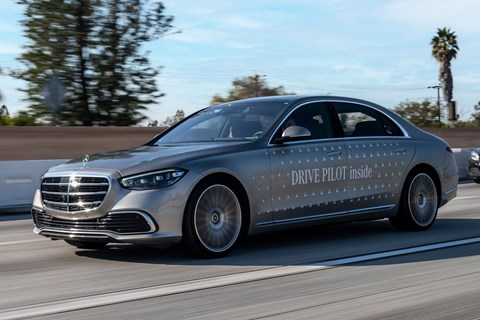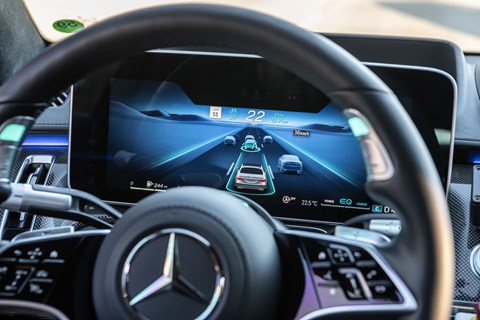► Brits free to watch telly in autonomous cars
► Proposals to update the Highway Code
► The latest on legals of driverless cars
The UK government is proposing to let drivers watch television once fully autonomous cars are rolled out – but they won’t be able to use their telephones and must be on standby to take over, it has emerged.
Proposed changes to the Highway Code will spell out what is and isn’t allowed, as ministers pave the way for the next tranche of trials of driverless cars. A series of interim measures were published in April 2022, ahead of a full regulatory framework due to be implemented by 2025.
Crucially, the government has confirmed that drivers will not be held responsible for crashes in autonomous cars; that burden will fall to insurance companies.
Autonomous cars and the law: who is accountable?
Mercedes is readying its new Level 3 self-driving technology on the new S-Class and EQS saloons – and the brand has confirmed that it is prepared to accept legal responsibility for accidents involving its cars when the system is engaged.
However, the firm’s acceptance of liability falls within a limited set of parameters. Mercedes says it will only take the blame for an accident if it was directly caused by a fault with its technology. If the driver ‘fails to comply with their duty of care’ (such as refusing to retake control of the car when prompted), they will be responsible for the resulting damage.
From launch, Mercedes’s Drive Pilot system will only work within geo-fenced areas on the German motorway network at speeds up to 60km/h (around 37mph) – but these limitations could be lifted once Mercedes has proved to legislators that the system works reliably.

As Drive Pilot is a Level 3 system, the driver will be able to take their hands off the wheel and allow the car to assume total control of its functions. Mercedes even says that owners will be able to perform “ancillary tasks” on the car’s infotainment system, such as replying to emails, watching a film or online shopping.
Mercedes is the first manufacturer in the world to meet the legal requirements for a Level 3 self-driving system, beating the autonomous pioneer Tesla to the punch. The German government granted Mercedes approval for the technology in late 2021 – and the first cars equipped with Drive Pilot will become available in early 2022.
This marks an enormous leap forwards in autonomous technology – until now, self-driving cars have required constant supervision from the driver. Big changes like these need to be backed up by big legal documents, though. Thankfully, the powers that be have already started to lay the foundations to protect road users if the worst should happen.
That’s good news. What are the latest developments?
In January 2022, the Law Commissions of England, Wales and Scotland published a joint report which called for legal reforms that would allow owners of self-driving cars to be immune from prosecution if something went wrong with their vehicles while they were operating in autonomous mode.
The report suggests that the person in the driving seat of a truly self-driving car, (like the Level 3-capable vehicles Mercedes is about to bring to market), is no longer a driver when the system is switched on. Instead, they are a ‘user-in-charge’ – which means they’d be exempt from a wide range of offences ranging from dangerous driving to speeding.
For example, if a self-driving car has an accident as a direct result of its autonomous system failing, then the responsibility for the prang should lie with the manufacturer rather than the owner as, technically, the owner wasn’t driving the car at the time. Seems fair enough, right?

The renowned safety body Thatcham was consulted as part of the report. The company’s chief research strategy officer, Matthew Avery, said: ‘The transition to safe introduction of automation with self-driving capabilities is fraught with risk as we enter the early stages of adoption. Today’s report is a significant step, as it provides important legal recommendations and clarity for the safe deployment of vehicles with self-driving features onto the UK’s roads.
‘In the next 12 months, we’re likely to see the first iterations of self-driving features on cars on UK roads. It’s significant that the Law Commission report highlights driver’s legal obligations and they understand that their vehicle is not yet fully self-driving. It has self-driving features that, in the near future, will be limited to motorway use at low speeds.’
He also discussed some limitations that should be placed on the ‘user-in-charge,’ saying: ‘The driver will need to be available to take back control at any time, won’t be permitted to sleep or use their mobile phones, the vehicle won’t be able to change lanes and if the driver does not take back control, when requested, it will stop in lane on the motorway. It is critical that early adopters understand these limitations and their legal obligations.’
This should go without saying, but the ‘user-in-charge’ will still be responsible for other driver duties, such as insurance, securing loads and making sure children are wearing their seatbelts. There will also need to be a system added to self-driving cars which logs when the system is active and relays information back to the manufacturer if any unsafe driving occurs during its uptime to help eliminate the bugs.
The Commissions have already relayed their report to Parliament and the Scottish Parliament. Now, it’s up to the UK, Scottish and Welsh Governments to decide whether to accept their recommendations and introduce laws to enforce them. We’ll update you as soon as we have more information on the proceedings.
Our guide to autonomous cars: what levels 1-5 mean